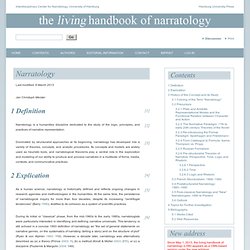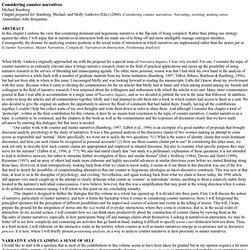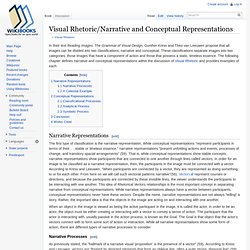

Www.diss.fu-berlin.de/diss/servlets/MCRFileNodeServlet/FUDISS_derivate_000000000305/05_kap4.pdf;jsessionid=278DCEE23C351370F7C2AB8171593308?hosts= ICI Berlin: Frank Ankersmit: Parts and the Whole of the (Historical) Text. Spatial Events. Narratology - the living handbook of narratology. Last modified: 8 March 2013 Jan Christoph Meister 1 Definition Narratology is a humanities discipline dedicated to the study of the logic, principles, and practices of narrative representation.

Dominated by structuralist approaches at its beginning, narratology has developed into a variety of theories, concepts, and analytic procedures. Its concepts and models are widely used as heuristic tools, and narratological theorems play a central role in the exploration and modeling of our ability to produce and process narratives in a multitude of forms, media, contexts, and communicative practices 2 Explication As a human science, narratology is historically defined and reflects ongoing changes in research agendas and methodologies in the humanities. During its initial or “classical” phase, from the mid-1960s to the early 1980s, narratologists were particularly interested in identifying and defining narrative universals. (i) Narratology is not the theory of narrative (Bal Bal, Mieke ([1985] 1997). Qualitative Netzwerkanalyse: Konzepte, Methoden, Anwendungen. Eclectic.ss.uci.edu/~drwhite/Complexity/net_hist_complexity.pdf.
Www.clarku.edu/~mbamberg/Papers/Counter Narratives.htm. Considering counter narratives Michael Bamberg Chapter prepared for: Bamberg, Michael, and Molly Andrews (Eds.) (2004).

Considering counter narratives: Narrating, resisting, making sense. Amsterdam: John Benjamins. In this chapter I endorse the view that countering dominant and hegemonic narratives is the flip-side of being complicit. When Molly Andrews originally approached me with the proposal for a special issue of Narrative Inquiry, I was very excited. Our earlier work with counter and master narratives (Bamberg, 1997; Talbot et al., 1996) is an exemplar of a good number of proposals that brought discourse-analytic psychology to the study of narratives.
This chapter is designed to further the dialogue that this volume as a whole has opened up. I would like to start with a question that in most of the contributions to this volume seems to have been taken for granted but in my opinion requires a bit more dialoguing: ‘Why narrative?’ Michael Bamberg Ph.D. Mr.

Bamberg received a Staatsexamen in German, Politics and Education from the Universität Marburg, Germany in 1975, an M.Phil. in Linguistics from the University of York, England in 1978, and a Ph.D. in Psychology from the University of California at Berkeley in 1985. He has been at Clark since 1986. Current Research and Teaching Mr. Bamberg's research is in the area of Discourse and Identity with an emphasis on how Narratives (particularly "Small Stories") are employed as general sense-making and identity-building strategies.
Selected Publications (Please contact the Editorial Office for reprint inquiries) Bamberg, M., De Fina, A., & Schiffrin, D. (2010). Bamberg, M. (2009). Bamberg, M., & Marchman, V. (2009). Bamberg, M., & Georgakopoulou, A. (2008). Visual Rhetoric/Narrative and Conceptual Representations. In their text Reading Images: The Grammar of Visual Design, Gunther Kress and Theo van Leeuwen propose that all images can be divided into two classifications, narrative and conceptual.

These classifications separate images into two categories: those images that have a component of action and those that possess a static, timeless essence. The following chapter defines narrative and conceptual representations within the discussion of Visual Rhetoric and provides examples of each. Narrative Representations[edit] The first type of classification is the narrative representation.
While conceptual representations "represent participants in terms of their. . . stable or timeless essence," narrative representations "present unfolding actions and events, processes of change, and transitory spacial arrangements" (59). When an object in the image is viewed as being the active participant in the image, it is called the actor. Narrative Processes[edit] A Celestial Example[edit] Analytical Process[edit]